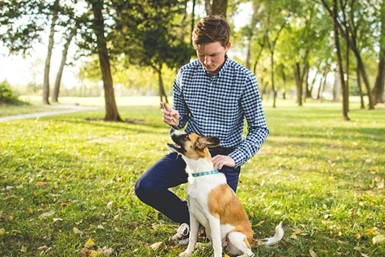Dogs will always be man’s best friend, but sometimes they don’t act like it.
No matter the breed, some form of consistent training is usually required to make sure they behave properly. Well, most of the time.
Marissa Corbett of Shamong, NJ discusses three of the most popular training approaches that encompass canine behavioral must-haves: heeling, coming when called, and leash manners. Here’s how to get started:
Walking on Heel
Walking on heel is a great skill to instill in a dog, especially for one who is very active. Heeling while walking refers to having a dog keep pace with their owner, next to them instead of in front or behind. It also involves having a dog stop whenever an owner stops.
The environment matters here. Start slow, perhaps inside the house where there is ample space to walk freely (keep some treats handy). Owners should indicate which side the dog should walk on.
When called and the dog comes to one’s preferred side, offer a treat. This may take a couple of repeated tries. Practice walking and stopping, and especially take breaks whenever a dog moves behind or gets too far ahead.
Consistency is key. Make eye contact and repeatedly indicate the space a dog should be in at any time. Go slowly, when they behave correctly, offer praises. Every few steps a dog takes that is in stride with an owner should be rewarded.
Come When Called
Teaching a dog to come when called is likely at the top of any owner’s behavior training list. It comes in handy throughout the life of every dog and can be critical for their safety.
Lessons on coming when called also begin with an incentive. A toy a small treat will work wonders when practicing this skill.
This training involves a bit of activity from the trainer. After the first successful “come,” run away a few feet and then start again, urging the dog to come to your new location.
When they come, reward them. Repeat the process but go a little further each time until it becomes easy to get a dog to come when they are in another room or come when they are in the backyard but need to come inside.

Leash Manners
Nothing can be as frustrating to a dog owner as constant leash pulling. Some dogs never get over it. But there is something that can be done about it.
Walking properly on a leash begins with introducing a dog to what it all entails. Show a dog not just the leash but the collar and have them try it on for size before even going out for walks, letting them gradually become comfortable.
It also helps to connect a collar and a leash to food or fun. Play with them while wearing a collar or give them a treat as the leash is attached.
Once a dog is comfortable on a leash inside, it’s time to move outdoors. Practicing walking on a leash for a short amount of time in an area they are familiar with; either a yard or a driveway will do. It’s important to ensure you and your dog are in the right mindset for this transition. Setting clear intentions and expectations for you and your dog and always ending on a positive note is key.
As for leash pulling? It will be something that takes the longest to get over, and even after training, a dog may excitedly pull on leash when entering a new terrain. However, a dog owner should stand firm — literally. When a dog is pulling, stop moving, and stand still until the yanking stops. Give verbal commands, such as “come” or “heel”. Teaching your best furry friend these three most important behaviors is important to a happy, polite life with your dog.

